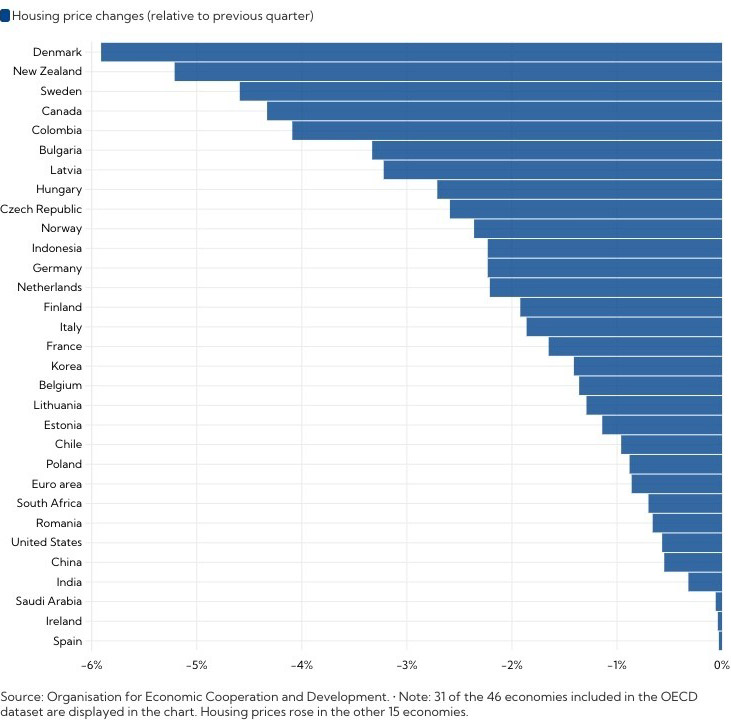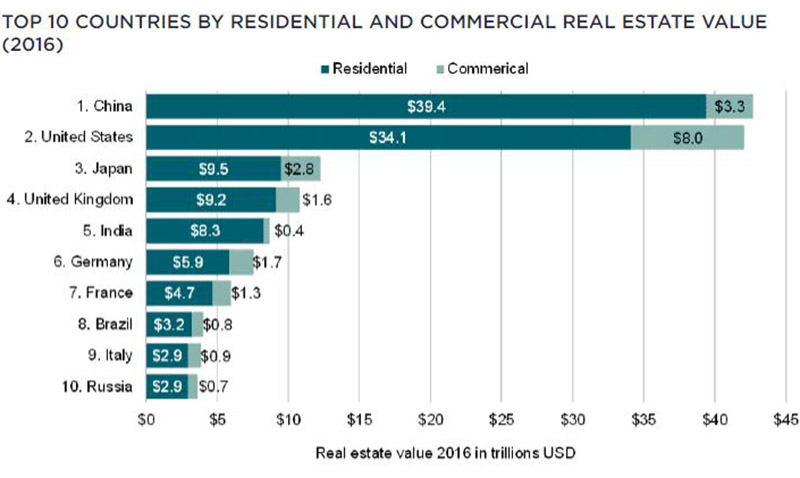Australia outperforming foreign real estate - so why is it ranked the second most risky in the world?
Australian property markets have been labelled by the IMF as the second riskiest in the world, despite outperforming the majority of other countries' real estate in 2023.
Australian property markets are a bit of a mixed bag at the moment but one thing is clear – it’s performing more robustly than much of the rest of the world.
Last month’s slight uptick in Australian property values may or may not have been the start of a more sustained turnaround after a year of price declines but compared to global trends it’s looking like a bit of an outlier in 2023.
In the past three months Australia’s property values have slipped 0.6 per cent this year after the quarterly declined was halved by the March upturn.
Two-thirds of the economies for which the Organisation for Economic Co-operation and Development (OECD) tracks, housing prices saw declines for their most recent quarter of available data.
Of 46 economies included in the OECD’s house price analysis, only 15 had prices rise, while the likes of Denmark, New Zealand, Sweden and Canada had dived by more than 4 per cent in just a few months and a majority of others had dipped by at least 2 per cent.

None of this, however, has stopped the International Monetary Fund (IMF) from, on Monday (17 April), ranking Australia as the second-highest country for ‘housing market risk’ out of 27 countries, behind only Canada.
The IMF scored countries on five different measures of housing market risk and argued that Australia was susceptible to high levels of debt compared to income and an overexposure to rising variable rates and could expect to fall from lofty price growth in the two years from March 2020.
“Every percentage point increase in the mortgage rate raises monthly interest payments for the average US homebuyer by $100, and the impacts can be more dire for buyers in countries with a predominance of adjustable rate mortgages (such as Australia),” the report noted.
Eliza Owen, Head of Residential Research, CoreLogic, countered the IMF finding, pointing out that a sharp decline in home values has already occurred.
National home values declined a record 9.1 per cent from their peak in April 2022, before recovering 0.6 per cent last month.
“While it may still be too early to call the bottom of the market, the steep price falls to date have seen limited increases in home loan defaults or forced sales,” Ms Owen said in response to the IMF research.
“Ultimately, the IMF reporting is important as it highlights key vulnerabilities in housing markets that exacerbate the risk associated with a surge in unemployment, but for now, there is room for cautious optimism about the Australian housing market.
“Many households have accrued strong savings buffers through the low interest rate period, and labour markets remain extremely tight.
“Housing market conditions are turning a corner amid low stock levels, rising demand from overseas migration, and consumer sentiment shifting higher as we approach what may be the end of the rate-tightening cycle.”
Global property dependent on central banks
A separate IMF report published by the World Economic Forum, also on Monday, stated that global housing markets are retreating after years of steady gains.
“Property markets should enjoy greater stability when central banks slow or pause their campaign of raising interest rates to tame inflation,” the IMF said.
“How long the decline in housing prices continues will depend on whether the rate hikes by central banks have already curtailed inflationary pressures.”
The IMF’s latest World Economic Outlook update forecasts inflation to be lower this year than it was in 2022 for about 85 percent of countries. Global inflation is expected to slow from almost 9 percent last year to about 6.5 percent this year and decelerate further next year, driven by the impact that rate hikes have already had on easing supply bottlenecks.
“If central banks slow or pause rate hikes, housing prices should then see greater stability,” the report noted.
A look at property around the world
Just 10 countries contain 70 per cent ($141.5 trillion) of all global commercial and residential value (totalling $200 trillion). China and the US together make up 42 per cent ($84.8 trillion) of global property value alone.
According to Savills, China is home to more of the world real estate market assets (by value) than any other country at $42.7 trillion or 21 per cent of global real estate value, just ahead of the US at $42.1 trillion.
Japan, the UK, India, Germany, France, Brazil, Italy and Russia round off the top 10, between them accounting for 28 per cent, or $56.8 trillion, of the global real estate asset total.
Savills estimates total residential and commercial property worldwide to be worth just over US$200 trillion. The vast majority of this is residential, accounting for 84 per cent, or $168.5 trillion.

Source: Savills.
A look at property markets around the word reveals most of facing a period of further downturns or the least, uncertainty.
United States
Following a 2.5 per cent drop in the second half of 2022, there is little consensus among economists, mortgage firms, banks, and real estate firms regarding whether the historically tight U.S. housing market will reverse course in 2023.
House prices soared 33 per cent during the two years of the pandemic
Home lender Freddie Mac’s Economic & Housing Research Group expects house prices to decline modestly in 2023 and predicts mortgage rates will drop from an average of 6.8 per cent in the fourth quarter of 2022 to 6.2 per cent in the fourth quarter of 2023. By comparison, Australia’s average mortgage rate is currently at 6.17 per cent.
The accounting firm KPMG’s forecast for the housing market in 2023 is bleaker.
It expects home prices to fall between 7 per cent and 10 per cent.
Existing home sales are predicted to drop by 23 per cent from 2022, which would be a decrease not seen since 2007. The drop is expected to be driven by single-family home sales due to the limited supply and high prices, however, high-rise apartments (condos) are predicted to fare better.
China
China’s property market crash has made world headlines, accompanied by images and tales of empty ghost cities, public protests that would usually be suppressed and homebuyers threatening repayment boycotts, and the collapse or financial deterioration of massive developers.
As some banks resort to allowing borrowers to pay off mortgages until they are 95-years-old, the country’s a historic property market downturn continues to spiral. New home prices had fallen for 16 straight months through December. Sales by the country’s top 100 developers last year were only 60 per cent of 2021 levels, according to CNN.
An astonishing 70 per cent of Chinese household wealth is now tied up in real estate.
China’s Bureau of National Statistics says the property market dropped 5.1 per cent in 2022 but unrest has been strongest in smaller cities, in many of which prices are believed to have fallen by 20 to 30 per cent.
Fitch Ratings says there are signs of the China property market stabilising but forecasts a 0 per cent-5 per cent decline in national new home sales and largely stable home prices this year, following a 28 per cent drop in sales in 2022.
United Kingdom
UK house prices annual decline had reached by 3.1 per cent in March, the biggest annual drop since 2009.
March’s fall of 0.8 per cent was the seventh monthly decline in a row and leaves prices 4.6 per cent below their most recent peak in August.
Halifax has forecast that average UK prices will fall by about 8 per cent this year, which it said, “would place the average property price back at roughly the level it was in April 2021, reversing only some of the gains made during the pandemic”.
The average price of a home in the UK is now A$476,000, compared to $764,000 in Australia.
Analysts have said that an expected fall in interest rates later this year could spur a pickup in sales, but that prices were likely to continue to fall.



















